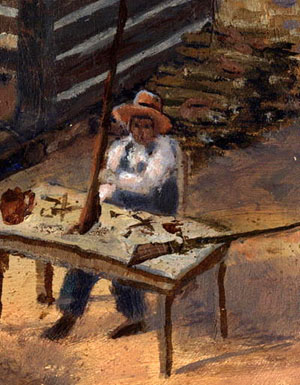
At a workbench next to the front porch, Ransom concentrates on repairing a neighbor's rifle. His nephew, Tom, watches intently, hoping to learn some of his uncle's techniques.
Farmers in the 1800's had to have a variety of skills and be very resourceful. They needed to understand basic principles of meteorology (climate), botany (plants) and animal husbandry (raising animals), of course. But they also had to be able to repair their equipment, build shelters and fences, and take care of the health of their livestock. A farmer with a special skill in one of those areas might add to the family income by doing additional work for neighbors.
Although no historical records have been found to verify this, the variety of gun parts found at the Williams' site suggests that Ransom may have repaired guns and other tools and machinery to make extra money for his family.
See what the archeologists found!
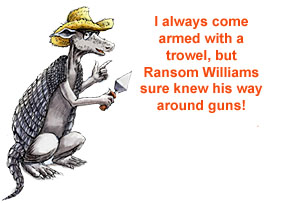
A gun was an important tool for people living in rural areas in the late 1800's. Farmers usually needed to hunt to add food to their family table. They also needed a weapon to protect their farm from intruders and their livestock from attacks by wild animals, such as wolves and coyotes. For these reasons, the archeologists were not surprised to find gun parts and ammunition at the Williams farm. They were a bit surprised, however, at the many types of gun-related artifacts they uncovered.
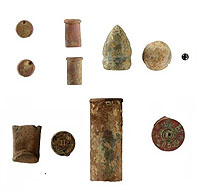
The archeologists found a wide variety of ammunition, including shells for .22, .32 and .42 caliber weapons. One 12-gauge shotgun shell has the name WINCHESTER engraved on it while another bears the name PETERS. Several cartridge cases, left over after the bullet is fired, were also found. They also uncovered the remains of different kinds of percussion caps used on muzzle-loading weapons of the Civil War period.
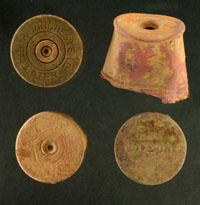
In addition to the ammunition, the archeologists found the rusted remains of a variety of weapons, including a hammer and breech plug. These were part of a black powder muzzle-loading shotgun. (Muzzle-loading guns were loaded from the top, or front end of the gun.) Based on cartridge heads, at least three shotguns are represented. A shotgun is a very versatile firearm that can be used for hunting birds and small game (like quail, dove, squirrels, and rabbits) as well as large game (such as deer). A shotgun could also provide a good deal of security and is an excellent close-range weapon for self defense. Living in an isolated location during the Jim Crow era, the Williamses were certainly aware of the potential for racial violence, and personal protection may have been an important consideration.
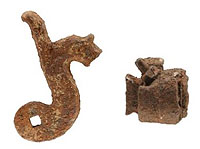
The picture below shows a type of gun that may have been used by one of Ransom's sons. Archeologists found a trigger guard that is probably from a Flobert rifle. Based on a picture from an 1895 mail-order catalog, this type of gun cost around $2.50. The Flobert was a single shot rifle often used for target practice. Because it was a simple and relatively inexpensive gun, it would have been a good choice for a kid's first gun.

Archeologists also found a part of an Enfield rifle, the oldest style of gun found at the farm. It was a brass butt plate which would have fit on the end of the gun, the part that rests against the shooter's shoulder. Prized for their accuracy, Enfield rifles were used widely during the Civi War by soldiers fighting on both sides. After the war, the large surplus of guns would have made this a relatively cheap, large caliber rifle to own. Click on the photo at right to learn how archeologists use small artifacts, such as a brass gun plate, to tell a larger story!
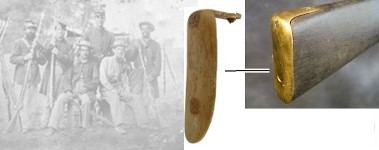
All these guns would have needed repairs from time to time, and the archeologists found several tools for just that use. A wrench used for working on a muzzle-loading gun and a pocket screwdriver are pictured at left. The screwdriver was a folding set that would have been used to disassemble and repair firearms.
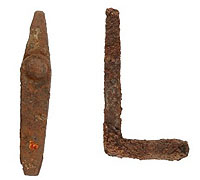
All in all, the archeologists believe that the ammunition and gun parts they found at the farmstead may represent as many as 10 different firearms. Several historians have found that most farmers owned more guns than plows during the 1800s! While we don't know for certain, the number of different weapons and the wide variety suggests that Ransom repaired guns to make additional income for his family. Like a skilled blacksmith, a man who knew how to repair guns would have been a valuable member of a farming community.
